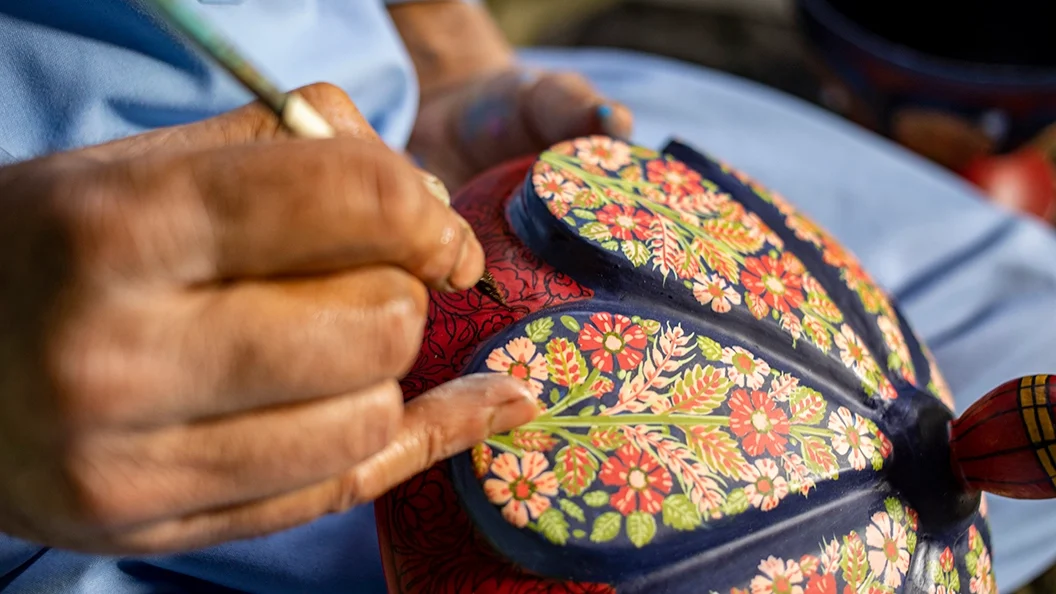
The Timeless Elegance of Kashmir: A Journey Through Its Arts and Crafts
In addition to its stunning scenery and tranquil beauty, Kashmir is well-known for its rich cultural legacy. The exquisite Kashmiri arts and crafts, which capture the customs, history, and craftsmanship of the area, are among its greatest treasures. These crafts have enthralled connoisseurs for centuries, from the exquisite Kashmiri embroidery to the elaborate patterns of genuine Pashmina shawls. The varied world of Kashmiri handicrafts, their difficulties, and the continuous attempts to preserve them are all covered in this blog.
- Pashmina Shawls:
The Royal Fabric Often referred to as “the fabric of kings,” pashmina wool is one of the most sought-after Kashmiri handicrafts. The soft undercoat of the Changthangi Pashmina goat, which is indigenous to the high-altitude Himalayan regions, is the source of the wool. Since genuine Pashmina shawls are hand-spun, hand-woven, and hand-embroidered, each one is unique in contrast to cashmere that is manufactured by machines.Natural dyes and traditional spinning wheels are used in the time-consuming process of creating a Pashmina shawl. Adding elaborate floral and paisley designs, Sozni embroidery, a delicate needlework technique, reflects Kashmiri artistry and Persian influences. The industry does, however, face difficulties like declining artisan interest, high raw material costs, and counterfeit goods. Protecting the authenticity of this art is the goal of Geographical Indication (GI) tags and government certification.
- Kashmiri Carpets: Crafting Everlasting Tales:
Handwoven Kashmiri carpets, which date back to the Mughal era, are a representation of elegance and wealth. These carpets have a thick and long-lasting texture because they are painstakingly made from premium wool and silk using the Persian knotted carpet weaving technique. Intricate geometric arrangements, tree-of-life patterns, and floral motifs are frequently used in designs.Genuine Kashmiri rugs take months or even years to make, in contrast to carpets that are manufactured by machines. However, this centuries-old custom is in danger due to shifting demand, political unrest, and growing competition from mass-produced carpets. By bringing artists and buyers from around the world together, initiatives like international exhibitions and online marketplaces support the industry.
- Papier-Mache: An Icon of Creative Expression:
Kashmiri papier-mâché, a delicate craft created by Persian artisans, turns paper pulp into ornamental items like jewelry boxes, bowls, and vases. Vibrant hand-painted motifs with geometric and floral patterns set the artwork apart.The demand for handmade Kashmiri papier-mâché is dwindling despite its cultural significance because of competition from low-cost, mass-produced substitutes. Programs for training artisans and partnerships with designers to introduce modern designs while maintaining traditional methods are two ways to bring this craft back to life.
- Wood Carving: Each Detail Is Beautiful:
Known for its intricate designs that adorn furniture, ceilings, and decorative panels, Kashmiri wood carving is an art form that flourished during the Mughal era. Khatamband, a traditional ceiling design created from interlocking wooden pieces without the use of nails, is among the most recognizable types of wood carving.Wood carving is still a highly valued craft, but there are issues with deforestation, waning artisan interest, and contemporary building methods. This traditional art can be preserved with the support of creative product diversification and sustainable sourcing.
- Kashmiri Embroidery: The Craft of Thread and Needle:
Kashmiri embroidery is renowned throughout the world for its exquisite craftsmanship and minute details, especially in Kashida and Aari work. Kashmiri shawls, pherans (traditional clothing), and home décor pieces are embellished with these embroidery designs. Using gold and silver threads, tilla embroidery is frequently used in festive and wedding attire.However, traditional craftsmanship is in danger due to mass-produced embroidered textiles. In order to ensure the survival of the craft, numerous artisans now work with fashion brands to showcase handcrafted Kashmiri embroidery to a worldwide audience.
- The Difficulties Kashmiri Handicrafts Face:
The following are the main dangers to Kashmiri arts and crafts.
– Handmade authenticity is being undermined by mass production and machine-made imitations.
– Trade and supply chains are disrupted by political instability.
– Lack of involvement among young people, as younger generations choose different professions.
– Decreasing artisans’ profit margins due to rising raw material costs. - Preservation Initiatives and Prospects:
The revival of Kashmiri handicrafts is the goal of several organizations, such as the Jammu and Kashmir Handicrafts Development Corporation and the Craft Development Institute in Srinagar. Global exhibitions and e-commerce platforms give artists the chance to present their creations to buyers around the world.Their legacy can be preserved by promoting fair trade, buying directly from craftspeople, and raising awareness of the distinctiveness of genuine Kashmiri handicrafts.
In conclusion, a legacy that should be preserved:
More than merely works of art, Kashmiri handicrafts are a rich cultural legacy that has been handed down through the ages. Every craft, from elaborate wood carvings to exquisite Kashmiri carpets and opulent Pashmina shawls, narrates a tale of beauty and tenacity.
We contribute to the preservation of Kashmir’s rich cultural heritage and the survival of its craftspeople in a world that is changing quickly by choosing to buy genuine handmade goods. In order to preserve Kashmir’s customs for future generations, let’s value and honor these ageless arts.


